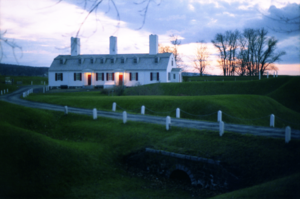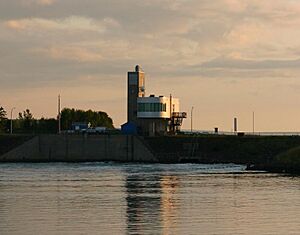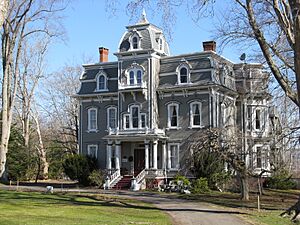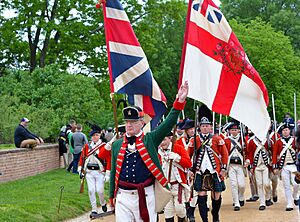Annapolis Royal facts for kids
Quick facts for kids
Annapolis Royal
Port-Royal (French)
|
||
|---|---|---|
|
Town and County seat
|
||
|
Waterfront of Annapolis Royal
View from Fort Anne looking south over Annapolis Basin
Saint Luke's Church
Pierre Dugua Monument
Lighthouse
View of Granville Ferry from Annapolis Royal
|
||
|
||
| Nickname(s):
Cradle of the Nation
|
||
| Country | Canada | |
| Province | Nova Scotia | |
| Municipality | Annapolis County | |
| Founded | 1605 as Port Royal | |
| Incorporated | 1892 | |
| Named for | Anne, Queen of Great Britain | |
| Electoral Districts Federal |
West Nova |
|
| Provincial | Annapolis | |
| Area
(2016)
|
||
| • Total | 2.04 km2 (0.79 sq mi) | |
| Highest elevation | 7 m (23 ft) | |
| Lowest elevation | 0 m (0 ft) | |
| Population
(2021)
|
||
| • Total | 530 | |
| • Density | 268.3/km2 (695/sq mi) | |
| Demonym(s) | Annapolitan | |
| Time zone | UTC-4 (AST) | |
| • Summer (DST) | UTC-3 (Atlantic Daylight Saving Time) | |
| Postal code |
B0S1A0
|
|
| Area code(s) | 902 | |
| Telephone Exchange | 526, 532 | |
| Official name: Annapolis Royal Historic District National Historic Site of Canada | ||
| Designated: | 1994 | |
Annapolis Royal is a town in and the county seat of Annapolis County, Nova Scotia, Canada. The community, known as Port Royal before 1710, is recognised as having one of the longest histories in North America, preceding the settlements at Plymouth, Jamestown and Quebec. For nearly 150 years, it served as the capital of Acadia and subsequently Nova Scotia until the establishment of Halifax in 1749.
In 1605, France established a settlement on the Annapolis Basin, centred on the habitation at Port Royal. By 1629, Scotland renewed the settlement, this time centred around Charles Fort, which is the site of the modern town. The settlement of Port Royal passed several times between France, Scotland, England and Great Britain until it was finally ceded to Great Britain in 1713. Due to its location on the boundary between the colonial powers of France and Great Britain, it encountered a grand total of thirteen assaults, surpassing all other locations in North America.
In 1994, the historic heart of Annapolis Royal, having been the site of critical moments in North America's development, was officially named a National Historic Site of Canada. The historic district is one of numerous National Historic Sites and two National Trust for Canada properties in and around Annapolis Royal. The town resides within the working landscape of the UNESCO designated, Southwest Nova Biosphere Reserve.
Formerly centred around military affairs and shipping, the town's primary economic focus has shifted to tourism.
Contents
- Toponymy
- History
- Demographics
- Geography
- Economy
- Historic sites and museums
- Arts and culture
- Education
- Sister cities
- Notable people
- Eponym
Toponymy
"Port Royal" originally referred to the Annapolis Basin and was named by cartographer Samuel de Champlain in 1604, writing, "we entered a harbour which is two leagues in length and one in breadth, which I have named Port Royal." The French settlement on the Annapolis Basin was named "Annapolis Royal" in honour of Queen Anne following the siege of Port Royal in 1710 by Great Britain.
History
Early history
The confluence of the Annapolis River and Allains Creek, the site of the modern town, was named Nme'juaqnek meaning "the place of bountiful fish" by the Mi'kmaq, who have lived in the area for thousands of years. A stone point excavated at Fort Anne was dated to two to three thousand years old.
Port Royal
The original French year-round settlement, centred on the habitation at Port-Royal, was established in 1605 by François Gravé Du Pont, Samuel de Champlain, with and for Pierre Dugua, Sieur de Mons. The habitation is approximately 10 km (6.2 mi) west of present-day Annapolis Royal on the Annapolis Basin. It was abandoned after being destroyed by attackers from Virginia in 1613, but was, significantly, the first year-round European settlement in Canada. It was also likely to have been the site of the introduction of apples to Canada in 1606.
In 1629, Scottish settlers, under the auspices of Sir William Alexander, established their settlement, known as Charles Fort, at the mouth of the Annapolis River. The settlement was transferred to the French under the terms of the Treaty of Saint-Germain-en-Laye in 1632 and 47 Scottish settlers, including men, women and children were removed, although some settlers remained. The settlement, under the French, soon became self-sufficient and grew modestly for nearly a century, though it was subject to frequent attacks and capture by English military forces or those of its New England colonists, only to be restored each time to French control by subsequent recapture or treaty stipulations. Acadia remained in French hands throughout most of the 17th century.
The seigneury of Port Royal was granted to Jean de Biencourt de Poutrincourt in 1604, although it was not exercised until 1605. This semi-feudal status of Port Royal and Annapolis Royal was in effect until 1733, but Seigneuresse Marie de Saint-Étienne de La Tour probably maintained the social status until her death in 1739. In 1733, Alexandre Le Borgne (1679-1744), the eldest surviving son of Seigneuresse Marie, petitoned to have the Seigenury restored to him, but was refused.
Creation of Annapolis Royal
In 1710, Port Royal was captured a final time from the French at the siege of Port Royal during Queen Anne's War, marking the British conquest of peninsular Nova Scotia. Queen Anne's War was the North American theatre the larger War of the Spanish Succession (1701–1714), fought between France and the Grand Alliance. The British named the town Annapolis Royal and Fort Anne after Queen Anne (1665–1714), the reigning monarch. Previously, under the French, the Annapolis River had been known as "Rivière Dauphin".
Siege of Annapolis Royal (1711)
After success in the local Battle of Bloody Creek, 600 Acadians and native warriors attempted to retake the Acadian capital. Under the leadership of Bernard-Anselme d'Abbadie de Saint-Castin they descended on Annapolis Royal and laid siege to Fort Anne. The garrison had fewer than 200 men, but the attackers had no artillery and were thus unable to make an impression on the fort. They eventually dispersed, and Annapolis Royal remained in British hands for the remainder of Queen Anne's War.
Under the 1713 Treaty of Utrecht, Acadia was formally granted to Great Britain; however, the vague boundary definitions saw only the peninsular part of Nova Scotia granted to Great Britain. The next half-century would see great turbulence as Britain and France vied for dominance in Acadia and in North America more generally. The indigenous Mi'kmaq were not a party to the treaty.
Father Rale's War
Father Rale's War (1722–1725) was a series of battles between the New England Colonies and the Wabanaki Confederacy, including the Mi'kmaq, who were allied with France.
Blockade of Annapolis Royal (1722)
During Father Rale's War, in July 1722 the Abenaki and Miꞌkmaq attempted to create a blockade of Annapolis Royal, with the intent of starving the capital. The natives captured 18 fishing vessels and prisoners from present-day Yarmouth to Canso. They also seized prisoners and vessels from the Bay of Fundy.
In response to the New England attack on Father Rale at Norridgewock in March 1722, 165 Mi'kmaq and Maliseet troops gathered at Minas to lay siege to the Lt. Governor of Nova Scotia at Annapolis Royal. Under potential siege, in May 1722, Lieutenant Governor John Doucett took 22 Mi'kmaq hostage at Annapolis Royal to prevent the capital from being attacked. Massachusetts Governor Samuel Shute declared war on the Abenaki.
New Englanders retrieved some of the vessels and prisoners after the Battle at Winnepang in which thirty-five natives and five New-Englanders were killed. Other vessels and prisoners were retrieved at Malagash Harbour after a ransom was paid.
Raid on Annapolis Royal (1724)
A key event of Father Rale's War was in early July 1724 when a group of sixty Mi'kmaq and Maliseets raided Annapolis Royal. They killed a sergeant and a private, wounded four more soldiers, and terrorized the village. They also burned houses and took prisoners. The British responded on July 8 by executing one of the Mi'kmaq hostages on the same spot the sergeant was killed. They also burned three Acadian houses in retaliation.
As a result of the raid, three blockhouses were built to protect the town. The Acadian church was moved closer to the fort so that it could be more easily monitored.
King George's War
During King George's War there were four attempts by the French, Acadians and Mi'kmaq to retake the capital of Acadia. King George's War was the North American theatre of the War of the Austrian Succession (1740–1748), predominantly fought between France and the Holy Roman Empire, with whom Great Britain was allied.
Siege of Annapolis Royal (July 1744)
Jean-Louis Le Loutre, the Vicar General for Acadia, gathered 300 Mi'kmaq warriors together, and they began their assault on Annapolis Royal on 12 July 1744. This was the largest gathering of Mi'kmaq warriors till then to take arms against the British. The Mi'kmaq outnumbered the New Englanders regulars by three to one. The assault lasted for four days, when the fort was rescued on 16 July by seventy New England soldiers arriving on board the ship Prince of Orange.
Siege of Annapolis Royal (September 1744)
After spending the summer trying to recruit the assistance of Acadians, François Dupont Duvivier, officer of the French colonial troupes de la marine, attacked Annapolis Royal on 8 September 1744. His force of 200 was up against 250 soldiers at the fort. The siege raged on for a week, and then Duvivier demanded the surrender of the fort. Both sides awaited reinforcements by sea. The fighting continued for a week and then two ships did arrive – from Boston, not Louisbourg. On board the ship was New England Ranger John Gorham and 70 natives. Duvivier retreated.
1745 Siege of Annapolis Royal
In May 1745, Paul Marin de la Malgue led 200 troops, together with hundreds of Mi'kmaq in another siege against Annapolis Royal. This force was twice the size of Duvivier's expedition. During this siege the English destroyed their own officers' fences, houses, and buildings that the attackers might be able to use. The siege ended quickly when Marin was recalled to assist with defending the French during the siege of Louisbourg in 1745.
During the 1745 siege, the Mi'kmaq and Maliseet took prisoner William Pote and some of Gorham's (Mohawk) Rangers. During his captivity, Pote wrote one of the most important captivity narratives from Acadia and Nova Scotia.
1746 siege of Annapolis Royal
Led by Ramesay, the French land forces laid siege to Annapolis Royal for twenty-three days, awaiting naval reinforcements. They never received the assistance they required from the Duc d'Anville Expedition and were forced to retreat.
Seven Years' War
The Seven Years' War (1756–1763), which was related to the French and Indian War, was primarily fought between France and Great Britain, in addition to their various allies.
1755 Deportation of the Acadians
During the expulsion of the Acadians, on December 8, 1755, 32 Acadian families, a total of 225, were deported from Annapolis Royal on the British ship Pembroke. The ship was headed for North Carolina. During the voyage, the Acadians took over the vessel. On 8 February 1756, the Acadians sailed up the Saint-John River as far as they could. They there disembarked and burned their ship. A group of Maliseet met them and directed them up stream, where they joined an expanding Acadian community. The Maliseet took them to one of Charles Deschamps de Boishébert et de Raffetot's refugee camps for the fleeing Acadians, which was at Beaubears Island.
In December 1757, while cutting firewood near Fort Anne, John Weatherspoon was captured by Indians, presumably Mi'kmaq, and carried away to the mouth of the Miramichi River. From there he was eventually sold or traded to the French and taken to Quebec, where he was held until late in 1759.
American Revolutionary War
Although invited to take part in the revolution by the Continental Congress, Nova Scotia remained largely loyal to Great Britain.
During the American Revolutionary War (1775–1783), the 84th Regiment of Foot (Royal Highland Emigrants) were stationed at Annapolis Royal to guard Nova Scotia against American Privateers. On October 2, 1778, the 84th Regiment was involved in the defeat of an American privateer at Annapolis Royal. Captain MacDonald sailed into the town only to find a large privateer ship raiding the port. He destroyed the privateer vessel, which had mounted ten carriage-guns.
However, in June 1780 the 84th Regiment was transferred to the Carolinas, leaving the town vulnerable to attack. The next year, on August 29, 1781, two large American privateer schooners attacked the undefended town. They imprisoned the men of the community in the fort and systematically looted houses in the town, even stealing window-glass from the church. The privateers fled when reports arrived that the militia was assembling outside the town. The only death took place when the privateers accidentally shot their own pilot. Two town residents were taken as hostages and later released on parole on promise of exchange for an American prisoner at Halifax.
Loyalists
After the American Revolution, more than 30,000 United Empire Loyalists migrated to the maritimes, many of them arriving in Annapolis Royal. The Loyalist migration severely taxed the resources of the town for a time before many moved to found Loyalist settlements such as nearby Digby and Clementsport, while others stayed. Some, such as Anglican minister Jacob Bailey, remained in Annapolis Royal and became members of the town's elite. Many escaped slaves who fought for the British known as Black Loyalists were also part of the Loyalist migration, including Thomas Peters, a member of the Black Pioneers regiment and an important Black Loyalist leader who first arrived in Annapolis Royal before taking land near Digby. Another notable Black Loyalist was Rose Fortune who founded a freight business and policed the Annapolis Royal waterfront. The Loyalists who remained in Annapolis Royal brought an injection of professions and capital that strengthened the town as a regional centre beyond its status as a garrison outpost.
19th century
Owing to the extreme tidal range, relatively shallow waters of the Annapolis Basin, and the small population of its hinterland, the port of Annapolis Royal, despite having a good harbour, carried on only a small trade through the 19th century. Along with Granville Ferry across the river, however, it was a local centre for shipbuilding. Among the notable local mariners was Bessie Hall. Following the replacement of sailing ships by steam in the 1880s, Annapolis Royal served as a coaling station between Saint John and Boston.
The town had a minor boom in 1869 when the Windsor and Annapolis Railway arrived, with two large railway piers built along the waterfront and several factories constructed in the area. The population reached 1,500 in the 1870s. Incorporation as a town under the Nova Scotia Municipalities Act took place in 1893. However, the completion of the railway to Digby in 1893, followed by the creation of the Dominion Atlantic Railway to Yarmouth, shifted most of the steamship commerce to those cities as steel-hulled vessels began to require deeper and deeper waters. By 1901, Annapolis Royal's population had shrunk to 1,019 and it became a small country town whose principal export was apples.
20th century and beyond
A ferry service ran from Lower Saint George Street across the river to Granville Ferry from the early 19th century, but a bridge was built in 1921 to link the two sides of the estuary. This bridge collapsed in 1961 and was replaced by a causeway, already under construction.
The Annapolis Royal Generating Station was a tidal power station located on the Annapolis River immediately upstream from the town of Annapolis Royal. The only tidal generating station in North America, it was capable of producing up to 20 MW twice daily with the change in tides. The generating station harnessed the tidal difference created by the large tides in the Annapolis Basin, a sub-basin of the Bay of Fundy. It opened in 1984 but has not produced power since 2019.
The town's burgeoning tourism industry in recent decades has driven significant commercial development. Additionally, the extensive availability of broadband internet has attracted entrepreneurial individuals from across Canada and beyond. In 1984, Annapolis Royal elected the first female black mayor in Canada, Daurene Lewis.
Demographics
| Historical population | ||
|---|---|---|
| Year | Pop. | ±% |
| 1971 | 758 | — |
| 1976 | 738 | −2.6% |
| 1981 | 631 | −14.5% |
| 1986 | 631 | +0.0% |
| 1991 | 633 | +0.3% |
| 1996 | 583 | −7.9% |
| 2001 | 550 | −5.7% |
| 2006 | 444 | −19.3% |
| 2011 | 481 | +8.3% |
| 2016 | 491 | +2.1% |
| 2021 | 530 | +7.9% |
In the 2021 Census of Population conducted by Statistics Canada, Annapolis Royal had a population of 530 living in 322 of its 364 total private dwellings, a change of 7.9% from its 2016 population of 491. With a land area of 1.98 km2 (0.76 sq mi), it had a population density of 267.7/km2 (693/sq mi) in 2021.
Geography
Annapolis Royal is situated in a good but shallow harbour at the western end of the fertile Annapolis Valley, nestled between the North and South mountains which define the valley. The town is on south bank of the Annapolis River facing the heavily tidal Annapolis Basin. The riverside forms the waterfront for this historic town. Directly opposite Annapolis Royal on the northern bank of the river is the community of Granville Ferry. Allains Creek joins the Annapolis River at the town, defining the western side of the community. The Bay of Fundy, on the other side of the North Mountain, is 10 kilometres north of the town.
The Annapolis Basin, Annapolis River, Annapolis County, and the Annapolis Valley all take their name from the town.
Climate
Annapolis Royal has a humid continental climate (Köppen Dfb) and typically has mild summers, cold winters and is wet all year.
| Climate data for Annapolis Royal (1981–2010) | |||||||||||||
|---|---|---|---|---|---|---|---|---|---|---|---|---|---|
| Month | Jan | Feb | Mar | Apr | May | Jun | Jul | Aug | Sep | Oct | Nov | Dec | Year |
| Record high °C (°F) | 18.5 (65.3) |
17.5 (63.5) |
21.7 (71.1) |
26.0 (78.8) |
30.0 (86.0) |
34.0 (93.2) |
32.2 (90.0) |
32.8 (91.0) |
30.0 (86.0) |
25.6 (78.1) |
22.2 (72.0) |
19.4 (66.9) |
34.0 (93.2) |
| Mean daily maximum °C (°F) | −0.7 (30.7) |
0.1 (32.2) |
3.4 (38.1) |
9.0 (48.2) |
15.8 (60.4) |
20.4 (68.7) |
23.3 (73.9) |
23.3 (73.9) |
19.0 (66.2) |
13.2 (55.8) |
8.0 (46.4) |
2.1 (35.8) |
11.4 (52.5) |
| Daily mean °C (°F) | −4.3 (24.3) |
−3.8 (25.2) |
−0.3 (31.5) |
5.1 (41.2) |
11.1 (52.0) |
15.5 (59.9) |
18.5 (65.3) |
18.6 (65.5) |
14.9 (58.8) |
9.6 (49.3) |
4.9 (40.8) |
−1.1 (30.0) |
7.4 (45.3) |
| Mean daily minimum °C (°F) | −7.8 (18.0) |
−7.6 (18.3) |
−4.0 (24.8) |
1.2 (34.2) |
6.2 (43.2) |
10.2 (50.4) |
13.3 (55.9) |
13.4 (56.1) |
10.3 (50.5) |
5.9 (42.6) |
1.7 (35.1) |
−4.1 (24.6) |
3.2 (37.8) |
| Record low °C (°F) | −26.0 (−14.8) |
−27.2 (−17.0) |
−24.4 (−11.9) |
−13.3 (8.1) |
−6.1 (21.0) |
−3.3 (26.1) |
−1.1 (30.0) |
0.0 (32.0) |
−2.2 (28.0) |
−8.3 (17.1) |
−13.3 (8.1) |
−23.9 (−11.0) |
−27.2 (−17.0) |
| Average precipitation mm (inches) | 114.4 (4.50) |
85.2 (3.35) |
94.3 (3.71) |
94.7 (3.73) |
86.4 (3.40) |
74.4 (2.93) |
68.7 (2.70) |
68.5 (2.70) |
110.3 (4.34) |
120.4 (4.74) |
125.3 (4.93) |
112.5 (4.43) |
1,155.2 (45.48) |
| Average rainfall mm (inches) | 59.5 (2.34) |
51.6 (2.03) |
67.0 (2.64) |
87.0 (3.43) |
86.0 (3.39) |
74.4 (2.93) |
68.7 (2.70) |
68.5 (2.70) |
110.3 (4.34) |
120.4 (4.74) |
118.0 (4.65) |
80.2 (3.16) |
991.8 (39.05) |
| Average snowfall cm (inches) | 54.9 (21.6) |
33.5 (13.2) |
27.3 (10.7) |
7.7 (3.0) |
0.4 (0.2) |
0.0 (0.0) |
0.0 (0.0) |
0.0 (0.0) |
0.0 (0.0) |
0.0 (0.0) |
7.3 (2.9) |
31.2 (12.3) |
162.4 (63.9) |
| Average precipitation days (≥ 0.2 mm) | 13.7 | 10.9 | 11.3 | 11.3 | 11.0 | 11.1 | 8.6 | 8.3 | 10.2 | 11.2 | 13.2 | 12.9 | 133.5 |
| Average rainy days (≥ 0.2 mm) | 6.1 | 5.5 | 7.6 | 10.4 | 10.9 | 11.1 | 8.6 | 8.3 | 10.2 | 11.2 | 12.4 | 8.5 | 110.7 |
| Average snowy days (≥ 0.2 cm) | 9.2 | 6.4 | 5.0 | 1.7 | 0.05 | 0.0 | 0.0 | 0.0 | 0.0 | 0.0 | 1.4 | 5.2 | 28.9 |
| Source: Environment Canada | |||||||||||||
Economy
Tourism
Tourism is a significant part of the economy of Annapolis Royal. Fort Anne, contained within the boundaries of the town, was initially designated a National Historic Park in 1917 and a National Historic Site in 1920. The current fort, built around 1703, was designed to defend the capital of Acadia / Nova Scotia from seaward attack. Today, much of the original earthen embankments may be visited, as well as some buildings original to the military facility and the Garrison Cemetery. This is the oldest formal cemetery in Canada, dating back to the French and later the British. The oldest English gravestone in Canada is among the graves, that of Bathiah Douglas who was buried in 1720. Rose Fortune, a Black Loyalist and the first female police officer in what is now Canada is buried here.
The town contains the Historic District of Annapolis Royal, the largest registered Historic District in Canada. Not only is the District itself a National Historic Site, but it also contains numerous individual National Historic Sites. These include Fort Anne, the Annapolis County Court House, the site of Charles Fort, the de Gannes-Cosby House and the Sinclair Inn.
The Annapolis Royal Historic Gardens is a 17-acre tourist attraction that has been operating since 1981. The site is managed by a non-profit registered charity. The attraction displays several periods of Canadian gardening history from the 17th century through to the modern era.
Various historical walking-tours are available in the town, particularly during the summer season; one of the more well-known being the late-night, candlelight Garrison Cemetery tour. The town has numerous art galleries and studios aimed at the tourist market.
Other
The town acts as a significant hub for commerce within the broader Annapolis County, catering to a population exceeding 21,000 residents.
The Annapolis Royal Farmers and Traders Market is situated on the town's waterfront. It convenes each Saturday from May through October, with additional sessions on Wednesdays from July to September. Live entertainment is a regular feature, typically offered on most Saturdays. Established in 1976, the current iteration of the market maintains a rich historical lineage, tracing its origins back to a market instituted by Acadian Governor Brouillan in this vicinity of Port Royal around 1701. This enduring tradition underscores the market's significance as a longstanding cultural and commercial hub within the region.
The extensive Annapolis Basin Conference Centre, and an adjoining small businesses park, are located near the town. They occupy the former site of CFB Cornwallis, which closed in the mid-1990s.
The scallop boat fleet based in the Annapolis Basin generates millions of dollars in economic activity annually, supporting numerous businesses in the Annapolis Royal area. The 'haul-up' facility adjacent to the wharf remains a key site for overhauling and refurbishing scallop boats each year.
Historic sites and museums
Annapolis Royal has numerous historic sites which are either, National Historic Site of Canada, National Trust for Canada, or a Nova Scotia Museum. These are either within the town or nearby.
- The Port-Royal National Historic Site is the location of the 1605 habitation and is also the location of a 20th-century reconstruction. It was the first National Historic Site to have a replica structure built.
- Fort Anne, which was also known as Charles Fort when first built in 1629, is Canada's oldest extant fort and its first National Historic Site. A seasonal museum operates on the site giving a history of the fort and the area.
- Although Charles Fort no longer exists above ground, a commemorative plaque indicates the site of the 1629 Scottish fort.
- The Historic District of Annapolis Royal is Canada's largest historic district containing 135 heritage properties spanning the 18th, 19th and early 20th centuries.
- At 404 km2 (156 sq mi) in size, Kejimkujik National Park is also a National Historic Site. It is a core part of the UNESCO designated Southwest Nova Biosphere Reserve. It is also designated a dark-sky preserve by the International Dark Sky Association.
- The De Gannes-Cosby House dates from 1708 and is recognised as the oldest wood-framed building in Canada and the world's oldest building in the Acadian style. The house is a private residence and not open to the public.
- The Annapolis County Court House, built in 1837, is one of the oldest courthouses in Canada that is still in use.
- The Melanson Settlement, located on the north shore of the Annapolis Basin, is a former Acadian settlement prior to deportation. It is an open archeological site with walking paths.
- The Bloody Creek National Historic Site is the location of both the Battles of Bloody Creek in 1711 and 1757.
- The Sinclair Inn is an Acadian building and seasonal museum which is also part of the National Trust for Canada. The focus of the museum is on the unique architecture of the building.
- The O'Dell House Museum is a seasonal museum and part of the National Trust for Canada. The house presents a collection of mainly 19th-century items related to the history of Annapolis Royal and the surrounding area.
- The North Hills Museum, located in Granville Ferry, is a seasonal museum and one of the oldest buildings in Canada. The museum presents a collection of furniture, ceramics, glasses, silverware and paintings.
Arts and culture
The town is known for a thriving music, theatre, art and culture scene. In 2014, it was listed by MacLean's magazine as "10 Places You've Got to See." The Annapolis Basin and Annapolis Royal are perhaps the location of some of the first theatrical productions in Canada with the Théâtre de Neptune, written by Marc Lescarbot (c. 1570–1641), performed in the harbour outside the Port Royal habitation on November 14, 1606. In 1743, Paul Mascarene, the Lieutenant Governor of Nova Scotia, translated Molière's La Misanthrope and staged productions that winter in Annapolis Royal.
Annapolis Royal hosts a lively contemporary art scene, with ARTsPLACE, managed by the Annapolis Region Community Arts Council, as its main art collective.
The town has a long-time town crier, who works closely with the mayor and town council on public events. Annapolis Royal hosted the International Town Criers Competition in 2017.
The two principal venues for theatre and performance in the town are the historic King's Theatre and the recently constructed Oqwa'titek amphitheatre. These venues host live performances by both local and international groups.
Each year, Natal Day is celebrated over the weekend of the first Monday in August. Events are held throughout the town and Fort Anne, such as live music, dances, historical reenactments and pipe bands, culminating in a parade on the final day.
Education
Annapolis Royal is within the Annapolis Valley Regional Centre for Education. Champlain Elementary School, in nearby Granville Ferry, services students from kindergarten to grade 5; while middle and high school students attend the Annapolis West Education Centre.
Sister cities
Annapolis Royal has two sister cities:
Notable people
- Chief Henri Membertou (1507–1611), National Historic Person and Grand Chief of the Mi'kmaq
- Charles de Menou d'Aulnay (1604–1650), National Historic Person and Governor of Acadia
- Samuel Vetch (1668–1732), National Historic Person and Royal Governor of Nova Scotia
- Noel Doiron (1684–1758), a notable Acadian leader
- Paul Mascarene (1684–1760), National Historic Person and Royal Governor of Nova Scotia
- Joseph Broussard (1702–1765), also known as "Beausoleil", a notable Acadian leader
- Erasmus James Philipps (1705–1760), member of the Nova Scotia Council
- John Bradstreet (1714–1774), British army officer
- Admiral Philipps Cosby (1729–1808), National Historic Person and Officer of Royal Navy
- Thomas Peters (1738–1792), founding father of Sierra Leone
- Admiral William Wolseley (1756 – 1842), National Historic Person and Officer of Royal Navy
- Sir William Winniett (1793–1850), abolitionist, Governor of the Gold Coast
- Sir Fenwick Williams (1800–1883), military leader and first Lieutenant Governor of Nova Scotia born in the province
- John William Ritchie (1808–1890), Father of Confederation
- Sir William Johnstone Ritchie (1813–1892), second Chief Justice of Canada
- Robert Knox Sneden (1832–1918), American civil war veteran, landscape painter and map-maker
Eponym
Minor planet 516560 Annapolisroyal was named in honor of the town by David D. Balam. The official naming citation was published by the Minor Planet Center on 25 September 2018 (M.P.C. 111804).




















